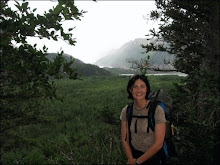
In late October, male Adelie Penguins begin to arrive at the colony from their winter foraging areas to stake out a territory. They often attempt to hold the same territory as in previous years, and fighting will break out if another male is on the old territory. The behavior seen above is called "flipper bashing". Adelies may seem cute and cuddly, but those flippers have a lot of muscle behind them. It is not uncommon to find bloodied, territory-less males wandering around in early November.

The territories are only as large as they need to be so that closely neighboring males cannot reach each other with their bills. These territory holding males will defend their territories and wait for their mate to arrive for up to several weeks.

As we arrived at Cape Crozier in mid November, most of the males were already at the colony with very well defined territories, and the females were arriving in droves from the sea. Here is a line of female Adelies making their way across the sea ice to the colony. They will go to the same nest they nested in last year in hopes that their partner is waiting for them there with a well built nest. If not, they will shop in the area for another suitable candidate.

Males will advertise themselves and their territory by performing the EV display or Ecstatic Vocalization. The EV is characterized by the penguin thrusting out his chest, throwing his head back, and vibrating his chest to make a repeated chuckling call. It is very sexy. This display lets other males know about the territory holding male and it is not uncommon to find an area with multiple males EVing at the same time.

The males will also collect rocks and build a large pile with a bowl in the middle, perfect for keeping eggs and hatchlings out of the mud. They often steal rocks from their neighbors' nests when they aren't watching. Early in the season, males seem to alternate between EVing, stealing rocks from each other, and trying to bite males that are stealing rocks from their own nests. Constant vigilance is very important.

Here is a female examining this male performing the EV display. He has a pretty decent pile of rocks and has yet to find his mate. If his mate does not arrive soon, he will attempt to attract a different female to mate with.

Penguin pair bonding involves lots of eyeing each other with their heads down and sidestepping towards each other.

They also perform the LHV, which is the standard way in which penguins greet each other. The LHV consists of both members of the pair waving their heads back and forth in time with each other and loudly calling. They will continue to LHV throughout the season any time one partner returns to the nest from a foraging trip.

Pairs that were mates in previous years briefly become acquainted with each other and then get down to the business of breeding. They will copulate several times over the next week until the female has laid two eggs. This time of year it is very easy to differentiate between males and females because the females always have two muddy footprints on their backs.

When the second egg is laid the female will quickly gather some more rocks for the nest and then head out to sea to forage for Crystal Krill. By this time she is very skinny from producing two very large eggs and must bulk up before beginning the long and difficult task of raising two fully grown chicks to nearly adult size.

She will forage at sea for one or two weeks, while the male incubates the egg. This is no small task for him, as he has already been fasting for a several weeks defending the territory. He will continue to burn fuel by keeping the eggs warm and defending the nest from other adult penguins and the resident egg-predators: the skuas. If she does not return before he uses all of his fat reserves, he will abandon the nest to feed himself.

Over the next month they will take turns incubating the eggs and foraging. The foraging trips will get shorter and shorter as the hatch date approaches, and in mid-December it is not uncommon to find both members of the pair at the nest, waiting for the chicks to hatch. By this time they have hopefully fattened up enough to last them until the end of the breeding season, as almost all of the fish and krill they gather from now on will go towards feeding two voracious chicks.









